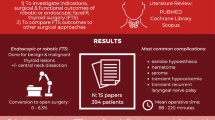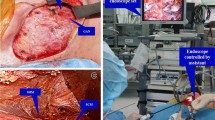Abstract
Background
Robotic facelift thyroidectomy (RFT) was developed as a new surgical approach to the thyroid gland using a remote incision site. Early favorable results led to this confirmatory multi-institutional experience.
Methods
Prospectively collected data on consecutive patients undergoing RFT in five North American academic endocrine surgical practices were compiled. Surgical indications, operative times, final pathology, nodule size, complications, and postoperative management (drain use and length of hospital stay) were evaluated.
Results
A total of 102 RFT procedures were undertaken in 90 patients. All but one of the patients (98.9 %) were female, and the mean age was 41.9 ± 13.1 years (range 12–69 years). The indication for surgery was nodular disease in 91.2 % of cases; 8.8 % were completion procedures performed for a diagnosis of cancer. The mean size of the largest nodule was 1.9 cm (range 0–5.6 cm). The mean total operative time for a thyroid lobectomy was 162 min (range 82–265 min). No permanent complications occurred. There were 4 cases (3.9 %) of transient recurrent laryngeal nerve weakness, no cases of hypocalcemia, and 3 (2.9 %) hematomas. There were no conversions to an anterior cervical approach. The majority of patients were managed on an outpatient basis (61.8 %) and without a drain (65.7 %).
Conclusions
RFT is technically feasible and safe in selected patients. RFT can continue to be offered to carefully selected patients as a way to avoid a visible cervical scar. Future prospective studies to compare this novel approach to other remote access approaches are warranted.



Similar content being viewed by others
References
Ohgami M, Ishii S, Arisawa Y et al (2000) Scarless endoscopic thyroidectomy: breast approach for better cosmesis. Surg Laparosc Percutan Tech 10:1–4
Ikeda Y, Takami H, Niimi M et al (2001) Endoscopic thyroidectomy by the axillary approach. Surg Endosc 15:1362–1364
Kang SW, Jeong JJ, Yun JS et al (2009) Robot-assisted endoscopic surgery for thyroid cancer: experience with the first 100 patients. Surg Endosc 3:2399–2406
Landry CS, Grubbs EG, Warneke CL et al (2012) Robot-assisted transaxillary thyroid surgery in the United States: is it comparable to open thyroid lobectomy? Ann Surg Oncol 19:1269–1274
Lin HS, Folbe AJ, Carron MA et al (2012) Single-incision transaxillary robotic thyroidectomy: challenges and limitations in a North American population. Otolaryngol Head Neck Surg 147(6):1041–1046
Perrier ND (2012) Why I have abandoned robotic-assisted transaxillary thyroid surgery. Surgery 152:1025–1026
Kuppersmith RB, Holsinger FC (2011) Robotic thyroid surgery: an initial experience with North American patients. Laryngoscope 121:521–526
Kandil E, Noureldine S, Yao L et al (2012) Robotic transaxillary thyroidectomy: an examination of the first one hundred cases. J Am Coll Surg 214:558–566
Singer MC, Seybt MW, Terris DJ (2011) Robot facelift thyroidectomy: I. Preclinical simulation and morphometric assessment. Laryngoscope 121:1631–1635
Terris DJ, Singer MC, Seybt MW (2011) Robot facelift thyroidectomy: II. Clinical feasibility and safety. Laryngoscope 121:1636–1641
Terris D, Singer MC, Seybt MW (2011) Robotic facelift thyroidectomy: patient selection and technical considerations. Surg Laparosc Percutan Tech 21(4):237–242
Terris DJ, Singer MC (2012) Qualitative and quantitative differences between 2 robotic thyroidectomy techniques. Otolaryngol Head Neck Surg 147(1):20–25
Byeon HK, Holsinger FC, Tufano RP et al (2014) Robotic total thyroidectomy with modified radical neck dissection via unilateral retroauricular approach. Ann Surg Oncol 12:3872–3875
Byeon HK, Kim DH, Chang JW et al (2015) Comprehensive application of robotic retroauricular thyroidectomy: the evolution of robotic thyroidectomy. Laryngoscope Nov doi: 10.1002/lary.25763. (Epub ahead of print)
Kandil E, Saeed A, Mohamed SE et al (2015) Modified robotic-assisted thyroidectomy: an initial experience with the retroauricular approach. Laryngoscope 125(3):767–771
Kandil E, Noureldine SI, Abbas A et al (2013) The impact of surgical volume on patient outcomes following thyroid surgery. Surgery 154(6):1346–1352
Bergenfelz A, Jansson S, Kristoffersson A et al (2008) Complications to thyroid surgery: results as reported in a database from a multicenter audit comprising 3,600 patients. Langenbecks Arch Surg 393:667–673
Sosa JA, Bowman HM, Tielsch JM et al (1998) The importance of surgeon experience for clinical and economic outcomes from thyroidectomy. Ann Surg 228(3):320–330
Byeon HK, Holsinger FC, Tufano RP et al (2014) Robotic total thyroidectomy with modified radical neck dissection via unilateral retroauricular approach. Ann Surg Oncol 21(12):3872–3875
Sung ES, Ji YB, Song CM et al (2016) Robotic thyroidectomy: comparison of a postauricular facelift approach with a gasless unilateral axillary approach. Otolaryngol Head Neck Surg 154(6):997–1004
Author information
Authors and Affiliations
Corresponding author
Rights and permissions
About this article
Cite this article
Duke, W.S., Holsinger, F.C., Kandil, E. et al. Remote Access Robotic Facelift Thyroidectomy: A Multi-institutional Experience. World J Surg 41, 116–121 (2017). https://doi.org/10.1007/s00268-016-3738-0
Published:
Issue Date:
DOI: https://doi.org/10.1007/s00268-016-3738-0




